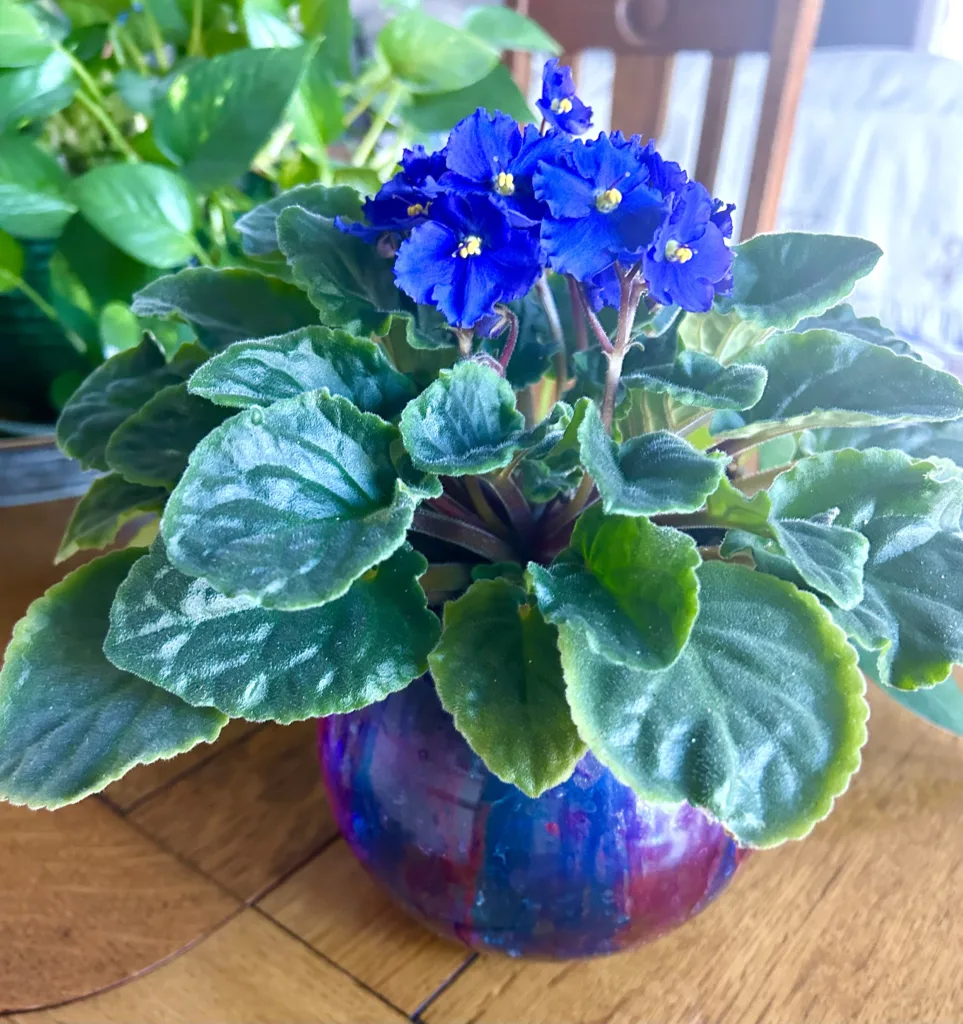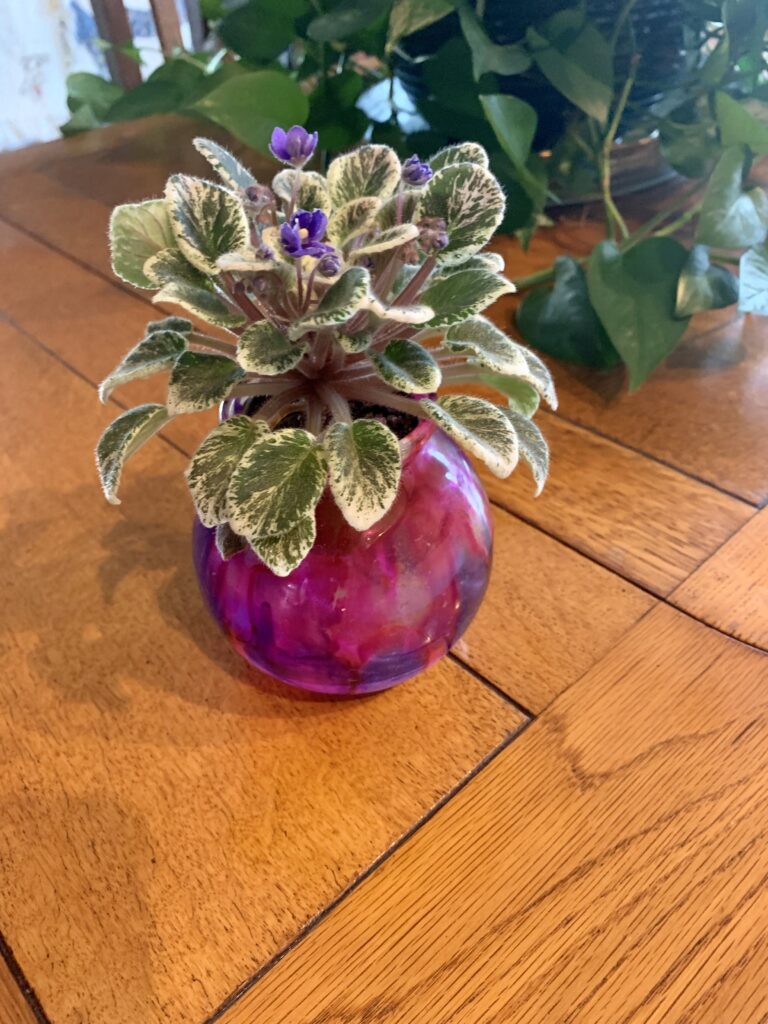
African violets (Saintpaulia) are beloved houseplants known for their beautiful blooms and fuzzy leaves. However, they can be quite finicky when it comes to watering. Overwatering or underwatering can lead to a variety of issues, including root rot and wilting. One effective method to ensure consistent moisture for your African violets is water wicking. This post will walk you through the process of setting up a water-wicking system using yarn, screen wire, and a combination of plastic pots and glass bowls or vases.
Materials Needed:
- Yarn (divided into 2 strands)
- Screen wire
- Plastic pots with drainage holes
- Glass bowls or vases (or used African violet water-wicking pots)
- African violet potting mix
- Water
- Liquid fertilizer
Step-by-Step Instructions:
Below are the step-by-step instructions on planting your African Violets in your water wicking pots. How to use the yarn for wicking, preparing the pot, planting, when to top off the water, fertilize and even how to create your own DIY water wicking pot.
1. Preparing the Yarn Wick
The first step is to prepare your yarn wick. Select a yarn made from natural fibers like cotton, or acrylic which is my preference. Cut a length of yarn that is long enough to reach from the top of the pot, through the soil, and into the water reservoir. For added wicking power, divide the yarn into two strands. I have found the 2 strands work best, wicking just enough water but not too much. This will enhance water absorption and distribution.
2. Preparing the Pot
Take a plastic pot with drainage holes at the bottom. To prevent soil from falling through these holes while allowing the yarn to wick water, cover the holes with screen wire. Cut a piece of screen wire slightly larger than the bottom of the pot and place it inside. I like to buy the pre-cut screen circles on Amazon for both my mini pots and my 4 inch pots. Just make sure it covers all the holes.
3. Setting Up the Wick
Thread the yarn double strand through a drainage hole, ensuring they extend from the top of the pot and long enough to extent into the water. The yarn should sit securely within the pot, with enough length to dangle into the water reservoir. I like to just run the yarn up the inside of the pot to just under where the soil line will be.
4. Adding Soil and Planting
Fill the pot with African violet potting mix, ensuring the yarn strand is just under the soil line. This special potting mix is designed to be light and airy, promoting good drainage and preventing the roots from becoming waterlogged. I have an African Violet soil recipe I use-you can just click here to view that post. Plant your African violet in the soil, positioning it at the same depth as it was in its previous container.
5. Creating the Water Reservoir
Now, it’s time to set up the water reservoir. You can use a glass bowl, vase, or a specially designed African violet water-wicking pot. The key is to choose a container that will hold water and allow the yarn wick to dangle into it. Place the pot with the African violet into the water reservoir, ensuring the ends of the yarn strands are submerged in the water. The pot should sit above the water line, with only the yarn wicking moisture up into the soil.
6. DIY African Violet Water Wicking Pots

If you’re looking for a cost-effective solution, you can create your own DIY African violet pots. Use a standard plastic pot for the plant and a glass bowl or vase for the water reservoir. The process remains the same: thread the yarn through the drainage holes, cover the holes with screen wire, fill the pot with soil, and place it in the water reservoir. I use these for the majority of my African Violets. I use a 4″ pot for the standard size and 2″ for the minis, I then find my glass bowls at thrift or craft stores. Also I like to color the outside of my vases using alcohol ink and they look beautiful when the sunlight hits them.
7. Filling the Water Reservoir
To fill the water reservoir, start by adding water to the container until it reaches just below the bottom of the pot. This ensures the yarn will effectively wick water into the soil without the pot itself sitting in water, which could lead to root rot. The frequency of refilling the water reservoir will depend on the size of the container, the humidity levels, and the specific needs of your African violet. I check the water level once a week and top it up as needed. Every other week I empty the water and replace it with fresh water to avoid any bacteria growth.
8. Adding Fertilizer
African violets benefit from regular feeding, but it’s important to use a balanced, African Violet water-soluble fertilizer specifically formulated for these plants. I use half strength and mix it with a gallon of water and top off or place the water each week. Although some people mix the fertilizer according to the package instructions and add it to the water reservoir every 2-3 weeks. Experiment and see what works best for you and your violets. This will allow the yarn to wick not only water but also nutrients up to the plant’s roots, promoting healthy growth and vibrant blooms.
9. Monitoring and Maintenance
Keep an eye on your African violet to ensure it is thriving. Signs of overwatering include yellowing leaves, wilting, and mold growth on the soil surface. If you notice these issues, reduce the frequency of refilling the water reservoir or consider using a thinner yarn to reduce the amount of water being wicked. Conversely, if your plant appears dry or the leaves are drooping, it may not be getting enough water, and you should check the wick for blockages or dryness.
10. Troubleshooting Common Issues
If you encounter problems with your water-wicking system, there are a few common issues to consider:
- Clogged Wick: Ensure the yarn is free of debris and not blocked by soil particles. You can rinse the yarn or replace it if necessary.
- Insufficient Wicking: If the soil remains dry, try using a thicker yarn or adding more strands to improve water absorption.
- Root Rot: Make sure the pot is not sitting directly in water and that the yarn is not wicking too much moisture. Adjust the water level in the reservoir accordingly.
Happy Gardening
Water wicking is an excellent method to maintain the ideal moisture level for your African violets. By following these steps, you can create a self-sustaining system that provides consistent hydration and nutrients to your plants, ensuring they remain healthy and vibrant year-round.
Please be sure to check out my Gardening Blog Post Page for more tips on all types of gardening. Including Seed Starting, Orchids, Water Gardening, Coldframe Gardening, Indoor Bulb Gardening, Hydroponics, Container Gardening, Mums, Herbs, African Violets, planting Bulbs, Flower Gardening, Vegetable and Fruit Gardening, Indoor Houseplants of all kinds, Cactus, Succulents, Hanging plants, Deer resistant plants and even Bird, Bee, Butterfly and Hummingbird Gardens!
